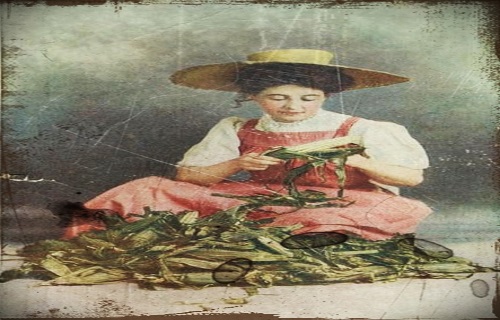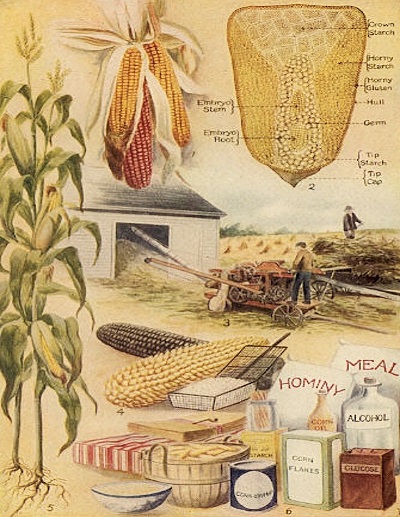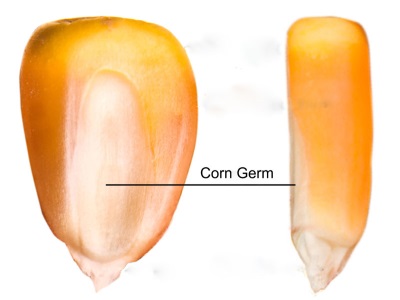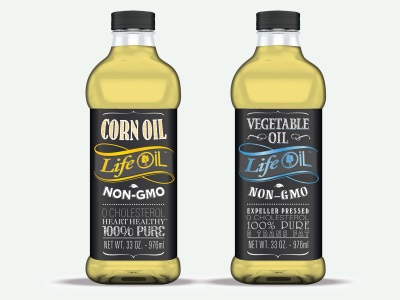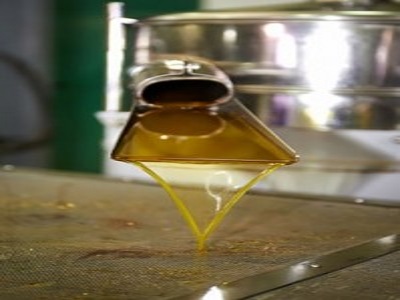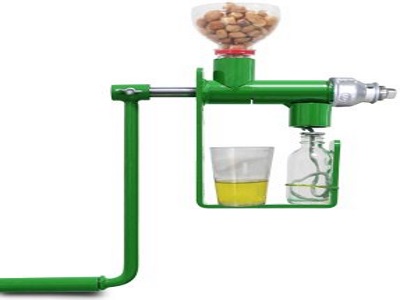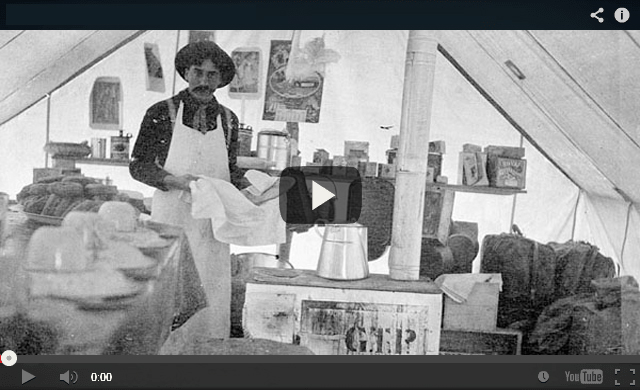Corn has been the cornerstone of the human diet for thousands of years; preserved kernels and cobs have been found at archaeological sites dating back thousands of years. The grain is believed to be native to the North American continent where it was one of the earliest domesticated crops. Remains of the first cornfields found in Puebla, Mexico date back to 5000 B.C.
The Indians originally called the grain teosinte, but as its use spread throughout South America and the Caribbean it became more commonly known as maize. In 1493, Christopher Columbus encountered the grain in Cuba and brought it home to Spain. Production of corn quickly spread throughout Europe and today, it is the most widely grown grain crop in the world.
Corn was usually planted together with beans and squash. Because the trio grew so well together the grouping was referred to as “The Three Sisters” in many tribes. The corn stalk provides support for the beans to grow up, and the squash spreads out to keep other plants from crowding the corn stalk. Originally, the fields consisted of mounds of earth a meter or two apart. Sometimes the mounds were in rows, other times they were randomly placed.
RELATED : The Pioneer Vegetable Garden & Natural Farming And Technique
Production
Corn is an annual crop traditionally planted in the spring and harvested in the fall. A portion of the crop is kept in its natural state and is used as livestock feed or as food. The majority of corn crops are refined by stripping the kernels from the cob and separating the grain’s main components, which include starch, oil, fiber and protein.
Word of the day: Prepare! And do it the old fashion way, like our fore-fathers did it and succeed long before us, because what lies ahead of us will require all the help we can get. Watch this video and learn the 3 skills that ensured our ancestors survival in hard times of famine and war.
Uses
Our ancestors didn’t worry about heart disease, cancer or diabetes. They didn’t fear Alzheimer’s or Parkinson’s disease. These diseases were incredibly rare before the 1900s, to the point where they didn’t need scientists to solve mysteries about their prevalence. There was no mystery! Our ancestors simply ate food (real food) and were nourished. Sure, there was illness and life was not perfect. But chronic degenerative diseases rates were incredibly low.
The leading cause of death before 1900 was usually one of four things: Infancy death, death from childbirth, death from infections, and death from accidents.Today, the leading causes of death are heart disease and cancer. Clearly, there’s something that needs to change.
The Corn Refiners Association lists over six broad categories of corn based products that stem from its main components: sweeteners, oils, starch, ethanol, animal feed and bio-products. Corn can be found in soft drinks, plastics, fabric and adhesives.
Corn oil is yellow, transparent oil with has a faint smell and faint taste. It is an easily absorbed vegetable oil which is not greasy. It is quite stable when frying at a high temperature, and can keep the color and flavor of vegetables and foods without losing the nutritive value. Blended with cold dish, it could lend a faint scent to the dish. Corn germ also has a long shelf life.
Corn oil has high content of unsaturated fatty acid
Corn oil is a rich source of unsaturated fatty acid, especially, linoleic acid. While it doesn’t contain cholesterol itself, it can also lower the cholesterol in blood, thus reducing the hardening influence on blood vessel. Long-term consumption can benefit patients suffering hypertension, adiposis, hyperlipidemia, diabetes, coronary heart disease, etc.
Corn oil contains rich vitamin A, D, and E
1. The vitamin A in corn oil can promote the growth of epithelial tissue and reduce the break out of dermatitis.
2. The vitamin D in corn oil can promote the absorption of Ca and is of great benefit to the growth of the bones of children.
3. The Vitamin E in corn oil is an antioxidant that can obviously prevent and cure xerophthalmus, nyctalopia, dermatitis, thrombophlebitis, muscular atrophy, and trophism Encephalomalacia etc. The vitamin E has also anti-aging effect. It can improve the endurance for exercise and chill. Adding into milk powder, it can help the growth of retina and cerebral cortex of infants.
How to make corn oil?
Corn oil is also called corn germ oil. It is made from corn germ, which is at the base of corn kernel. The most fat of corn kernel is in the corn germ.
Corn germ can be pressed by integrated screw oil press. This machine is one of the advanced oil presses. It can squeeze and filter oil at the same time with high oil yield and large capacity, labor-saving and energy-saving. The temperature is controlled automatically.
What is the difference between corn oil and vegetable oil?
About.com Middle Eastern foods explains that both corn and vegetable oils are used interchangeably in the kitchen. However, corn oil is made from the germs of corn kernels; and, vegetable oil is derived primarily from soy beans. Vegetable oil can sometimes be a blend of different types of oils.
Vegetable oil has a very mild taste, even at room temperature. So it has an appealing taste in foods that are served cold or at room temperature, such as mayonnaise. Corn oil, on the other hand, takes on a different flavor when it is heated versus when it is served at room temperature. At room temperature, it has a slight hint of corn flavor. For this reason, corn oil is not recommended for foods served cold or at room temperature. When corn oil is heated, however, its flavor profile transforms, making it a particularly good choice of oils for frying.
Both corn oil and vegetable oil are considered part of the category of “all purpose” oils. This means that they can be used for a wide variety of purposes and food preparations as opposed to specialty oils, such as rapeseed or coconut oil, which are more prominent in the preparations of certain types of cuisines.
How to Choose the Suitable Oil Press Machine?
When you are choosing an oil press machine, don’t forget to take these factors into account. If you want to produce quality oil with very little amount, you are going to buy a cold press oil machine. However if you are going to produce large amount of oil at a very short time, you should buy hot press oil machines instead.
A hot pressing machine is best if you are looking for large amounts of oil. Hot pressing machine is the best choice on the subject of extracting extensive quantities of oil out of oil bearing materials. By heating the seed paste, it is possible to let the coagulation process much faster thereby making it simpler to extract a great deal of oil from oil bearing materials. The other advantage of the hot pressing machines is that they can extract oil at a very short time. For commercial ventures, a hot pressing oil machine is the greatest since quantity affects the profit margin. More oil means more money.
As to the cold pressing,the oil produced by this methods are of great high quality. During cold extraction, ripe fruit or seeds are ground to a paste which is fed into a grinder. As 10 to 15 % of oil will remain in the press cake after milling, this procedure is quite expensive. It is only used for extracting oil from seeds with a very high oil content, such as olives and sunflowers. Cold pressed oils have a distinct flavor and intense color, whereas refined oils are lighter and usually clearer.
How to make corn oil at home
You can make your own corn oil at home. This is the only way to be sure that you have natural corn oil without additives. It is possible to achieve 2.5 lbs. of corn oil from a bushel of dried corn. So how to make corn oil at home?
You will need
Bushel of corn
Garlic press or mechanical press
Strainer
Bucket
Maize oil press is used to press maize oil, compared with old equipment, normal yield efficiency of maize oil press can be 3-6% higher, and the economic benefit is very considerable. The same output but it can reduce electricity consumption by 40%, on average every hour to save six kwh, one day can save the electricity bill of 36 Yuan, the same output it can save 60% of the power, 1 to 2 people can then be production, save labor cost, about 30 Yuan every day. This maize oil press can use peanuts, sesame, benne, rapeseed, sunflower seed, cottonseed, soybean and so on the many kinds of crops as raw materials. The oil produced by the maize oil press is pure, vacuum filter residual, the oil squeezing out without pollution authentically meet hygiene epidemic prevention requirements.
The process is simple.
Set up your machine.
Fill the heating unit with the recommended flammable and light.
Allow it to heat – this takes about 10 minutes.
Pour your seeds into the hopper.
– it takes about 20 minutes to make 14 ounces of oil. That’s about a 2-liter bottle full of seeds.
Press the corn. The mechanical press will crush the corn to a pulp as you turn the crank. By the time you have pressed the corn as far as it will go, you will have a runny, pulpy goo. This is just what you want. Each time that you press the corn, scrape the goo into the tub or bucket. The corn oil in the goo will float on top of the water and the pieces of the kernels will separate and float in the water. Continue pressing until all of the corn has been pressed and all of the goo is in the tub.
Remove your container of fresh oil and cap tightly.
Clean your machine.
Siphon off the oil and discard the sediment.
Store for up to 2 years in a tightly-sealed container in a cool, dry place.
Different oils have different shelf lives but for the most part, seed and nut oils are good for at least a year, and often 2-3. If the oil is rancid, it will change colors and smell off. The taste won’t be pleasant, either.
Our grandfathers had more knowledge than any of us today and thrived even when modern conveniences were not available. They were able to produce and store their food for long periods of time. The Lost Ways is the most comprehensive book available. All the knowledge our grandfathers had, in one place.Here’s just a glimpse of what you’ll find in the book:
Table Of Contents:
Making Your Own Beverages: Beer to Stronger Stuff
Ginger Beer: Making Soda the Old Fashioned Way
How North American Indians and Early Pioneers Made Pemmican
Wild West Guns for SHTF and a Guide to Rolling Your Own Ammo
How Our Forefathers Built Their Sawmills, Grain Mills,and Stamping Mills
How Our Ancestors Made Herbal Poultice to Heal Their Wounds
What Our Ancestors Were Foraging For? or How to Wildcraft Your Table
How North California Native Americans Built Their Semi-subterranean Roundhouses
Our Ancestors’Guide to Root Cellars
Good Old Fashioned Cooking on an Open Flame
Learning from Our Ancestors How to Preserve Water
Learning from Our Ancestors How to Take Care of Our Hygiene When There Isn’t Anything to Buy
How and Why I Prefer to Make Soap with Modern Ingredients
Temporarily Installing a Wood-Burning Stove during Emergencies
Making Traditional and Survival Bark Bread…….
Trapping in Winter for Beaver and Muskrat Just like Our Forefathers Did
How to Make a Smokehouse and Smoke Fish
Survival Lessons From The Donner Party
Get your paperback copy HERE
Here’s just a glimpse of what you’ll find in The Lost Ways:
From Ruff Simons, an old west history expert and former deputy, you’ll learn the techniques and methods used by the wise sheriffs from the frontiers to defend an entire village despite being outnumbered and outgunned by gangs of robbers and bandits, and how you can use their wisdom to defend your home against looters when you’ll be surrounded.
Native American ERIK BAINBRIDGE – who took part in the reconstruction of the native village of Kule Loklo in California, will show you how Native Americans build the subterranean roundhouse, an underground house that today will serve you as a storm shelter, a perfectly camouflaged hideout, or a bunker. It can easily shelter three to four families, so how will you feel if, when all hell breaks loose, you’ll be able to call all your loved ones and offer them guidance and shelter? Besides that, the subterranean roundhouse makes an awesome root cellar where you can keep all your food and water reserves year-round.
From Shannon Azares you’ll learn how sailors from the XVII century preserved water in their ships for months on end, even years and how you can use this method to preserve clean water for your family cost-free.
Mike Searson – who is a Firearm and Old West history expert – will show you what to do when there is no more ammo to be had, how people who wandered the West managed to hunt eight deer with six bullets, and why their supply of ammo never ran out. Remember the panic buying in the first half of 2013? That was nothing compared to what’s going to precede the collapse.
From Susan Morrow, an ex-science teacher and chemist, you’ll master “The Art of Poultice.” She says, “If you really explore the ingredients from which our forefathers made poultices, you’ll be totally surprised by the similarities with modern medicines.” Well…how would you feel in a crisis to be the only one from the group knowledgeable about this lost skill? When there are no more antibiotics, people will turn to you to save their ill children’s lives.
If you liked our video tutorial on how to make Pemmican, then you’ll love this: I will show you how to make another superfood that our troops were using in the Independence war, and even George Washington ate on several occasions. This food never goes bad. And I’m not talking about honey or vinegar. I’m talking about real food! The awesome part is that you can make this food in just 10 minutes and I’m pretty sure that you already have the ingredients in your house right now.
Really, this is all just a peek.
The Lost Ways is a far–reaching book with chapters ranging from simple things like making tasty bark-bread-like people did when there was no food-to building a traditional backyard smokehouse… and many, many, many more!
Books can be your best pre-collapse investment.
The Lost Ways (Learn the long forgotten secrets that helped our forefathers survive famines,wars,economic crisis and anything else life threw at them)
Survival MD (Best Post Collapse First Aid Survival Guide Ever)
Conquering the coming collapse (Financial advice and preparedness )
Liberty Generator (Build and make your own energy source)
Backyard Liberty (Easy and cheap DIY Aquaponic system to grow your organic and living food bank)
Bullet Proof Home (A Prepper’s Guide in Safeguarding a Home )
Family Self Defense (Best Self Defense Strategies For You And Your Family)
Survive Any Crisis (Best Items To Hoard For A Long Term Crisis)
Survive The End Days (Biggest Cover Up Of Our President)

